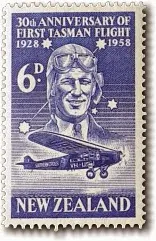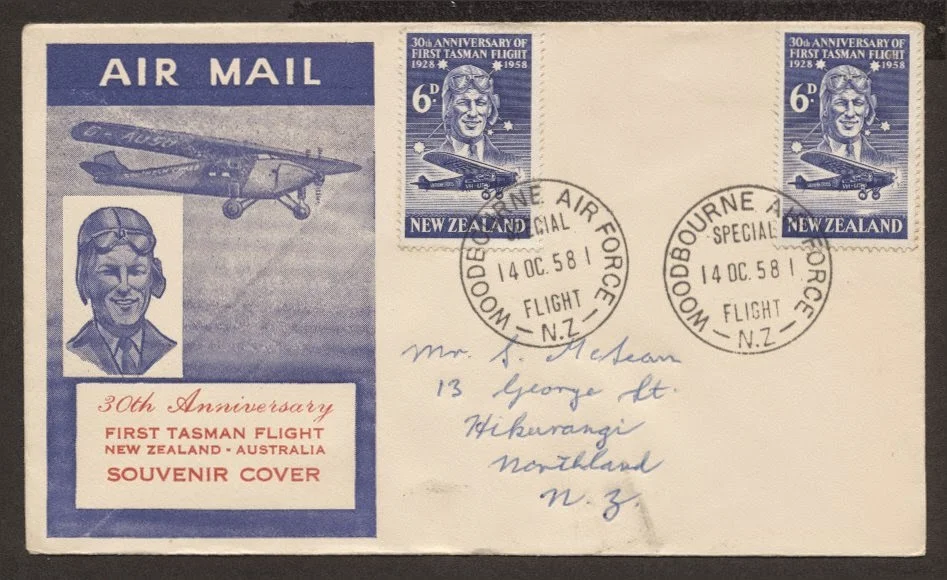1958 First Trans-Tasman Flight 30th Anniversary
- Kingsford Smith.
6d New Zealand. 8d Australia.
This stamp was issued to commemorate the 30th anniversary of Sir Charles Kingsford Smith's first Trans-Tasman flight with Charles T.P. Ulm as co pilot. The stamp was issued jointly by Australia and New Zealand (both shown here). The stamp featured the Southern Cross with the portrait of Sir Charles Kingsford Smith and his aircraft, also called Southern Cross.
This stamp was the subject of the miniature sheet issued by NZ Post
Below is a special cover posted from the Woodbourne Air Force Base.
1958 Nelson City Centennial.
Nelson has the unique distinction among New Zealand cities of having been constituted a city before it was a borough. In 1858, Queen Victoria ordained that Nelson should be a Bishop's See and therefore it achieved the status of a city before it fulfilled the statutory qualification of having sufficient population.
Nelson is a city on the eastern shores of Tasman Bay, and is the economic and cultural centre of the Nelson region. The Nelson Tasman economy is based on the 'big four' industries; seafood, horticulture, tourism and forestry. Port Nelson is the biggest fishing port in Australasia. There are also a range of growth industries, including art and craft, aviation, engineering technology, and information technology.
3d - Seal of the Diocese of Nelson.
The Seal of the Diocese of Nelson represented Nelson's Cathedral City status.
A view of the Nelson Cathedral is shown the First Day Cover below.
First Day Cover - 29th September, 1958.
1958 Hawke's Bay Centennial.
Hawke's Bay (Māori: Heretaunga) is a region of New Zealand on the east coast of the North Island. It is recognised on the world stage for its award-winning wines. Hawke's Bay Regional Council sits in both the cities of Napier and Hastings. It derives from Hawke Bay which was named by Captain James Cook in honour of Admiral Edward Hawke who decisively defeated the French at the Battle of Quiberon Bay in 1759.
This set of stamps commemorates the centennial of the province of Hawke's Bay. The stamps depicted three significant features of the Province: The Maori legend of Pania, Cape Kidnappers Gannet Sanctuary and sheep shearing. They were designed by three different designers. The design of the 2d stamp was completed by M R Smith, the 3d by J Berry and the 8d by LC Mitchell.
3d - Gannet nesting grounds at Cape Kidnappers.
2d - Pania Statue. 8d - Sheep Shearer.
2d - Pania Statue - in recognition of the important part played by Maoris in the development of the Hawkes Bay.
See our post Pania of the Reef.
3d - Gannet at Cape Kidnappers. In recognition of the awakening tourist industry in the Hawkes Bay Region.
8d - Sheep Shearer in recognition of the largest industry in the region.
First Day Cover - 3rd November 1958.
First Day Cover - 3rd November 1958.
A major perforation shift.
Notice the printers name underneath the design image. It can be seen more clearly here but is also noticeable on each of the values of this issue. I think this is rather unusual to include that information under every stamp on the sheet.
Technical information - Kingsford Smith.
Date of Issue:
| 27 August 1958 |
|---|---|
Designers:
| J E Lyle, Auckland |
Printers:
| Australian Bank Note and Stamp Printer, Australia |
Stamp Size:
| 25mm x 38mm |
Sheet Size:
| 120 stamps per sheet |
Process:
| Recess printed - Intaglio |
Paper Type:
| Wiggins Teape 'Esparto', multiple NZ and star watermark |
Technical information - Nelson Centennial.
Date of Issue:
| 29 September 1958 |
|---|---|
Designers:
| M J MacDonald, Nelson |
Printers:
| Bradbury Wilkinson, England |
Stamp Size:
| 24.5mm x 28.5mm |
Sheet Size:
| 160 stamps per sheet |
Process:
| Recess printed - Intaglio |
Perforation Gauge:
| 13.5 x 13 |
Paper Type:
| Wiggins Teape 'Esparto', multiple NZ and star watermark |
Technical information - Hawke's Bay Centennial.
Date of Issue:
| 3 November 1958 |
|---|---|
Designers:
| M R Smith, Levin; J Berry, Wellington and L C Mitchell, Wellington |
Printers:
| Harrison and Sons, England |
Stamp Size:
| 2d and 8d: 24mm x 28mm; 3d: 41mm x 25mm |
Sheet Size:
| 120 stamps per sheet |
Process:
| Photogravure |
Paper Type:
| Guard Bridge, multiple NZ and star watermark |
Some of the images in this post were used with permission from the illustrated catalogue of StampsNZ
You can visit their web site and On-line Catalogue at, http://stampsnz.com/











We appreciate your engagement with our content. To ensure a respectful and constructive community, please take note of the following:
- No Spam, Please: We do not tolerate spammy or promotional comments. Any such comments will be promptly removed.
- Moderation in Place: All comments are moderated to maintain a positive and inclusive environment. Please be patient, as it may take a little time for your comment to appear.
- Sign In with Google: To comment, please sign in using your Google account. This helps us maintain the integrity of our community and allows for better interaction.